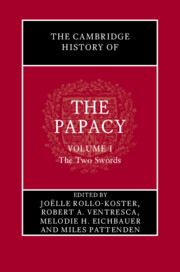Refine search
Actions for selected content:
156 results
Introduction: Beginnings, Endings, Myths
-
-
- Book:
- The Cambridge Companion to the Spanish Inquisition
- Published online:
- 04 December 2025
- Print publication:
- 18 December 2025, pp 1-20
-
- Chapter
- Export citation
13 - Mass Murder in the German-Occupied East, 1941–1944
- from Part IV - Criminality and Occupation
-
-
- Book:
- The Cambridge Companion to the Nazi-Soviet War
- Published online:
- 13 November 2025
- Print publication:
- 20 November 2025, pp 229-247
-
- Chapter
- Export citation
3 - Against the Galileans II
-
- Book:
- The Narrative Conflict of Traditions in the Late Antique World
- Published online:
- 22 September 2025
- Print publication:
- 09 October 2025, pp 99-118
-
- Chapter
- Export citation
Jewish Militias As a Factor in Post-World War One State Building in Galicia
-
- Journal:
- Central European History , First View
- Published online by Cambridge University Press:
- 06 August 2025, pp. 1-19
-
- Article
-
- You have access
- Open access
- HTML
- Export citation
Jewish Occupational Attainment in the Antebellum USA: Filling a Gap in the Literature
-
- Journal:
- Social Science History / Volume 49 / Issue 3 / Fall 2025
- Published online by Cambridge University Press:
- 20 June 2025, pp. 670-696
- Print publication:
- Fall 2025
-
- Article
-
- You have access
- Open access
- HTML
- Export citation
4 - Testimony as a Response to Mass Atrocity: 1940s to the Present
- from Part I - History
-
-
- Book:
- The Cambridge History of the Holocaust
- Published online:
- 16 May 2025
- Print publication:
- 12 June 2025, pp 103-120
-
- Chapter
- Export citation
14 - Hiding and Passing as Non-Jews in Poland, 1942–1945
-
-
- Book:
- The Cambridge History of the Holocaust
- Published online:
- 16 May 2025
- Print publication:
- 12 June 2025, pp 233-248
-
- Chapter
- Export citation
2 - In Each and Every Generation: Survivors and Their Descendants
- from Part I - History
-
-
- Book:
- The Cambridge History of the Holocaust
- Published online:
- 16 May 2025
- Print publication:
- 12 June 2025, pp 55-80
-
- Chapter
- Export citation
1 - Liberation, Displacement, and Homecoming in the Aftermath of the Holocaust
- from Part I - History
-
-
- Book:
- The Cambridge History of the Holocaust
- Published online:
- 16 May 2025
- Print publication:
- 12 June 2025, pp 35-54
-
- Chapter
- Export citation
24 - John Chrysostom, First Oration against the Jews
- from Part IV - Policing the Community
-
-
- Book:
- The Cambridge Edition of Early Christian Writings
- Published online:
- 19 May 2025
- Print publication:
- 12 June 2025, pp 475-496
-
- Chapter
- Export citation
12 - Jews in Concentration Camps, 1933–1945
-
-
- Book:
- The Cambridge History of the Holocaust
- Published online:
- 16 May 2025
- Print publication:
- 12 June 2025, pp 202-217
-
- Chapter
- Export citation
22 - Mixed Race, Mixed Marriage, and Jewish Christians
-
-
- Book:
- The Cambridge History of the Holocaust
- Published online:
- 16 May 2025
- Print publication:
- 12 June 2025, pp 365-381
-
- Chapter
- Export citation
Introduction to Volume IV
-
-
- Book:
- The Cambridge History of the Holocaust
- Published online:
- 16 May 2025
- Print publication:
- 12 June 2025, pp 8-32
-
- Chapter
-
- You have access
- HTML
- Export citation
General Introduction
-
- Book:
- The Cambridge History of the Papacy
- Published online:
- 28 February 2025
- Print publication:
- 20 March 2025, pp 1-32
-
- Chapter
- Export citation
General Introduction
-
- Book:
- The Cambridge History of the Papacy
- Published online:
- 28 February 2025
- Print publication:
- 20 March 2025, pp 1-32
-
- Chapter
- Export citation
General Introduction
-
- Book:
- The Cambridge History of the Papacy
- Published online:
- 28 February 2025
- Print publication:
- 20 March 2025, pp 1-32
-
- Chapter
- Export citation
Was There a Habsburg Jewish Experience?
-
- Journal:
- Austrian History Yearbook / Volume 56 / May 2025
- Published online by Cambridge University Press:
- 19 March 2025, pp. 1-10
- Print publication:
- May 2025
-
- Article
-
- You have access
- Open access
- HTML
- Export citation
5 - Religion and the Global History of Europe
-
-
- Book:
- Globalizing Europe
- Published online:
- 06 March 2025
- Print publication:
- 13 March 2025, pp 66-75
-
- Chapter
- Export citation

The Cambridge History of the Papacy
-
- Published online:
- 28 February 2025
- Print publication:
- 20 March 2025
“Paper Nation” Jews as a Religion, Minority, and Nation in Bureaucratic Discourse and Praxis in Russian Imperial and Post-Imperial States
-
- Journal:
- Nationalities Papers , FirstView
- Published online by Cambridge University Press:
- 18 February 2025, pp. 1-17
-
- Article
-
- You have access
- Open access
- HTML
- Export citation
